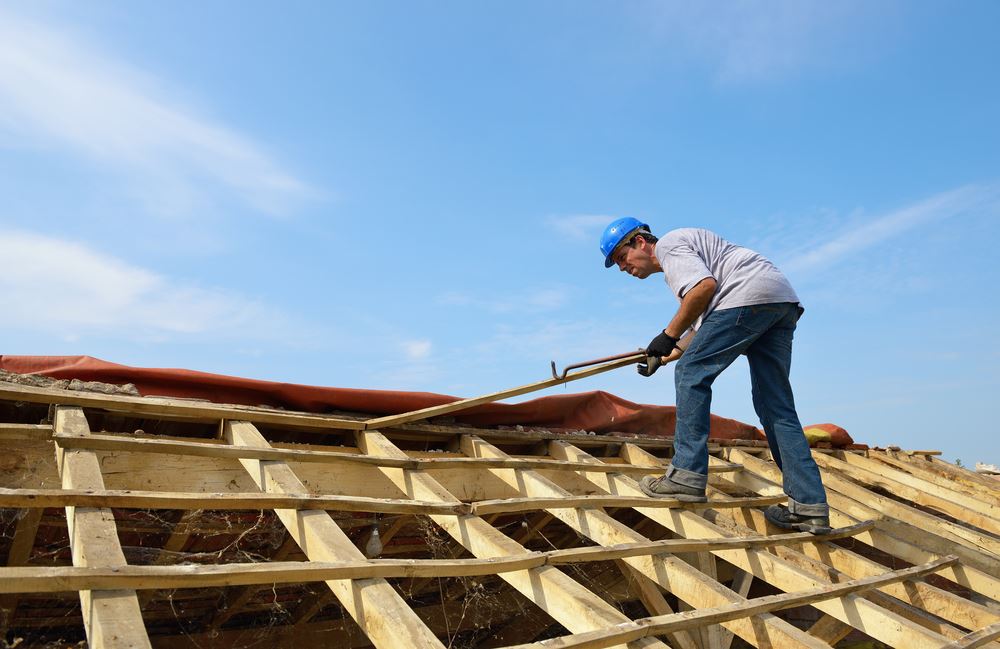When it comes to home construction and maintenance, the question, “How long does a roof last in Texas?” often arises. With various climates, from the coastal humidity of the Gulf Coast to the dry heat of West Texas, understanding the longevity of roofs in this diverse state is essential.
Brief History of Roofing in Texas
The history of roofing in Texas is as diverse and expansive as the state itself. With early settlers predominantly using materials that were readily available like clay, thatch, and wood, Texas roofs have always been an adaptation to their environment. As the state developed, the introduction of more modern materials like asphalt shingles, metal, and slate came into use, each offering unique benefits in combating the Texas climate.
Significance of Roofing in the Texas Climate
Given the Texas climate’s variability, roofing is critical in protecting homes and structures from harsh weather conditions. Whether it’s withstanding the strong winds of the Panhandle, shielding against the relentless sun in the south, or battling the heavy rains and potential hurricanes along the coast, the question of “how long does a roof last in Texas” is inextricably tied to the state’s diverse weather patterns. Understanding this relationship will help homeowners make more informed decisions about the best roofing materials and home maintenance practices.
The Influence of Texas Weather on Roof Lifespan
The Texas climate ranges from subtropical in the eastern regions, arid desert in the west, to continental in the Panhandle. This diversity brings a variety of challenges to the longevity of roofs. With an average of 232 sunny days and a wide range of temperatures throughout the year, understanding the Texas climate is crucial when assessing how long a roof lasts in Texas.
Impact of Sun and Heat
One of the primary challenges to a Texas roof’s lifespan is the relentless sun and heat. Over time, constant exposure to ultraviolet (UV) rays can degrade roofing materials, causing them to crack, warp, or fade. Heat can also cause materials to expand and contract, leading to potential structural damage. For this reason, heat- and UV-resistant materials are often the best choice for Texas roofs.
Effect of Storms and High Winds
Storms, particularly those bringing high winds, are common in many parts of Texas. Wind can lift and remove roofing materials, expose the underlayment, and even cause structural damage. Homes in areas prone to strong winds may require additional roof reinforcement to enhance their longevity.
Influence of Hail and Snow
While snow is not a common concern in most of Texas, hail is a frequent threat to a roof’s lifespan. Hailstones can cause significant damage, denting and cracking roofing materials. This is especially true for roofs made of asphalt shingles, which may require more frequent replacement after severe hailstorms.
Effect of Humidity and Moisture
Coastal and eastern regions of Texas experience high humidity levels and heavy rainfall, leading to concerns about moisture and potential water damage. Excessive moisture can lead to mold, rot, and structural degradation. Therefore, effective waterproofing and regular maintenance are key for maximizing a roof’s lifespan in these regions.
Lifespan of Different Roofing Materials in Texas
Asphalt Shingles: Pros, Cons, and Lifespan
Asphalt shingles are a popular choice due to their affordability and easy installation. They offer fair resistance to heat and can withstand moderate wind speeds. However, they may degrade faster under intense UV radiation and can sustain damage from hail. With proper maintenance, asphalt shingles can last approximately 15 to 25 years in Texas.
Metal Roofs: Pros, Cons, and Lifespan
Metal roofs are durable, fire-resistant, and excellent at reflecting UV rays, making them suitable for Texas’s hot climate. They can also withstand high winds and are largely impervious to hail. On the downside, they are more expensive to install. A well-maintained metal roof can last 40 to 70 years in Texas.
Clay or Concrete Tiles: Pros, Cons, and Lifespan
Clay and concrete tiles are highly durable, offering excellent resistance to heat, UV radiation, and fire. However, they can be prone to damage from high winds and hail. They are also heavy, requiring robust structural support. With proper care, clay or concrete tile roofs can last 50 to 100 years in Texas.
Slate Roofs: Pros, Cons, and Lifespan
Slate roofs are known for their longevity and resistance to heat and fire. However, like clay and concrete, they are heavy and may be susceptible to hail damage. They also come with a higher initial cost. A slate roof can last over 100 years with adequate maintenance in Texas.
Wood Shakes: Pros, Cons, and Lifespan
Wood shakes provide a unique aesthetic and good insulation but require more maintenance in Texas’s climate. They can be susceptible to rot and termites, especially in humid regions, and can pose a fire risk in hot, dry areas. The lifespan of a well-maintained wood shake roof in Texas can range from 20 to 30 years.
Composite Roofs: Pros, Cons, and Lifespan
Composite roofs, made of a mixture of materials, offer good durability and resistance to wind, fire, and UV radiation. They come in various styles and colors and are generally low-maintenance. However, they may not be as long-lasting as some other materials. In Texas, a composite roof can last around 30 to 50 years.
Key Factors Affecting Roof Longevity
Quality of Roofing Materials
The quality of roofing materials plays a significant role in answering the question, “How long does a roof last in Texas?” High-quality materials tend to withstand the harsh Texas weather better, offering greater durability and longevity. Choosing materials with a proven track record in Texas’s climate is crucial.
Quality of Installation
The longevity of a roof also heavily depends on the quality of its installation. Poorly installed roofs can lead to various issues, including leaks, poor ventilation, and increased susceptibility to weather damage. Therefore, it’s crucial to hire an experienced, reputable roofing contractor for the job.
Maintenance and Regular Check-ups
Regular maintenance is key to maximizing a roof’s lifespan. This includes cleaning gutters, replacing damaged shingles, and addressing small issues before they become significant problems. Regular professional check-ups can help identify potential issues early on, extending the roof’s lifespan.
Roof Ventilation and Insulation
Proper ventilation and insulation can significantly impact a roof’s longevity in Texas. Good ventilation reduces heat build-up in the summer, while effective insulation keeps the home warmer in the winter, reducing the strain on the roof. Both help prevent damage and extend the life of the roof.
Impact of Nearby Trees and Vegetation
Nearby trees and vegetation can also affect a roof’s lifespan. Overhanging branches can scrape and damage roofing materials, while leaves can clog gutters, leading to water damage. Regular trimming of overhanging branches and keeping gutters clear can mitigate these risks and contribute to the overall longevity of a roof in Texas.
The Importance and Process of Roof Maintenance in Texas
Periodic Inspection and Cleaning
Regular inspections and cleaning are the first steps toward prolonging the life of your roof. Homeowners should conduct an inspection at least twice a year, and after significant weather events. This includes checking for damaged shingles, signs of leaks, and clogged gutters. Professional roof cleaners can remove harmful elements like moss and algae that can degrade roofing materials over time.
Timely Repair and Replacement
When problems are spotted during an inspection, timely repair is essential. Prompt action can prevent further damage, whether replacing a few damaged shingles or addressing a minor leak. In some cases, a complete roof replacement may be necessary, particularly if it is past its expected lifespan.
Proper Insulation and Ventilation
Maintaining the roof’s insulation and ventilation system is crucial for its longevity. Ensuring adequate ventilation will help to keep the roof and attic cool during the hot Texas summer, while good insulation will retain heat during the cooler months. Both will help to prevent extreme temperature fluctuations that can damage roofing materials.
Dealing with Pest Infestation
Regular inspections can also help to spot signs of pest infestations, like termites or rodents, that can cause significant damage to a roof. If an infestation is detected, professional pest control services should be enlisted to deal with the problem, followed by repairs to any damage they may have caused.
Insurance and Warranties
Finally, it’s important to understand what your homeowner’s insurance and roof warranties cover. Some insurance policies may cover roof damage caused by weather events, while warranties typically cover defects in materials or installation. Ensuring you have the proper coverage can help with the costs of maintaining and repairing your roof, ensuring it lasts as long as possible in the Texas climate.
Final Words
In summary, “How long does a roof last in Texas?” depends on various factors. These include the type of roofing materials used, the quality of installation, regular maintenance and inspection, proper ventilation and insulation, and the influence of nearby vegetation. Texas’s diverse climate plays a significant role in a roof’s lifespan, making the choice of roofing materials and maintenance practices crucial.
Optimal Roof Choices for Texas Homeowners
For Texas homeowners, the best roof choice will depend on the specific climate of their area. Metal roofs and clay or concrete tiles offer excellent durability and resistance to the Texas heat, while composite roofs provide good overall performance. However, regular maintenance and inspections are essential, regardless of the material chosen.
Maintenance Tips for Long-lasting Roofs
To ensure your roof lasts as long as possible, perform regular inspections and cleaning, promptly deal with any repairs or replacements, maintain proper insulation and ventilation, and manage nearby vegetation. It’s also important to understand your insurance coverage and any warranties that may apply to your roof.
Frequently Asked Questions
What is the Average Lifespan of a Roof in Texas?
The average lifespan of a roof in Texas depends on the type of material used. It can range from 15 to 25 years for asphalt shingles, 40 to 70 years for metal roofs, and up to 100 years or more for clay, concrete, or slate roofs.
How Often Should I Replace My Roof in Texas?
The frequency of roof replacement will depend on the roof’s material, the quality of installation, and how well it’s been maintained. However, as a general rule, you might expect to replace asphalt shingles every 15 to 25 years, a metal roof every 40 to 70 years, and a tile or slate roof potentially only once in a lifetime.
How Can I Extend the Life of My Roof in Texas?
To extend the life of your roof in Texas, regular maintenance and inspections are key. Ensuring the roof is properly ventilated and insulated, dealing promptly with any necessary repairs or replacements, and managing nearby vegetation can also contribute to a longer lifespan.
What Roof Material is Best for the Texas Climate?
For the Texas climate, heat- and UV-resistant materials like metal, clay, or concrete tiles can be particularly effective. However, the best choice will depend on the specific conditions in your area, and a professional roofing contractor can help you make the best decision.
What Insurance Options are Available for Roofs in Texas?
Homeowners’ insurance policies typically cover roof damage caused by uncontrollable storms, hail, or fire. However, coverage can vary, so it’s important to read your policy carefully. Some roofing materials may also come with manufacturer’s warranties that cover defects in the materials or installation.

